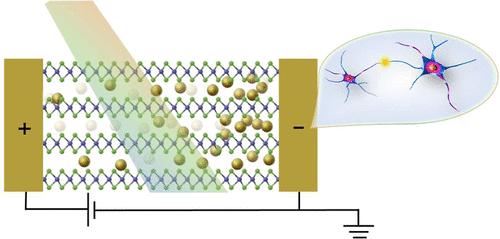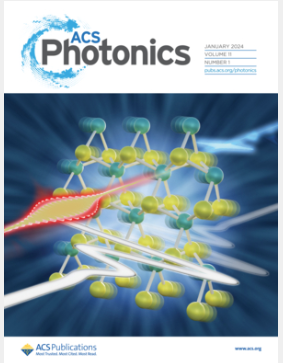多状态神经形态联想学习的可重构离子迁移驱动记忆电阻器
IF 6.7
1区 物理与天体物理
Q1 MATERIALS SCIENCE, MULTIDISCIPLINARY
引用次数: 0
摘要
自适应、多态神经形态和光子记忆器件的发展对于推进具有复杂学习和决策能力的智能系统至关重要。然而,传统设备在实现这种仿生功能所需的同时、可调谐的电气和光学响应方面面临局限性,通常需要复杂的电路或特定材料的修改,从而阻碍了可扩展性和集成。在这里,我们提出了一种可重构的、离子迁移驱动的基于wse2的忆阻器,通过在光导和光伏状态之间实现多态、可逆切换来解决这些挑战。采用第一性原理计算来研究Pd迁移机制,揭示了受控制的Pd离子运动如何动态调节器件的能带结构并有助于其多态功能。最终,该器件实现了显著的整流比──高达3个数量级──和光电压调制范围约为±0.5 V。这些功能允许该设备在响应外部刺激和内部状态时模拟联想学习和多条件决策,直接支持神经形态应用。这些进步与集成友好的制造工艺相结合,强调了该设备在安全通信、自适应信号处理和可扩展神经形态系统方面的潜力。本文章由计算机程序翻译,如有差异,请以英文原文为准。

Reconfigurable Ion-Migration Driven Memristor for Multistate Neuromorphic Associative Learning
The development of adaptive, multistate neuromorphic and photonic-memristive devices is essential for advancing intelligent systems capable of complex learning and decision-making. However, conventional devices face limitations in achieving simultaneous, tunable electrical and optical responses required for such biomimetic functions, often necessitating complex circuitry or material-specific modifications that hinder scalability and integration. Here, we present a reconfigurable, ion-migration driven WSe2-based memristor that addresses these challenges by enabling multistate, reversible switching between photoconductive and photovoltaic states. First-principles calculations were employed to investigate the Pd migration mechanism, revealing how controlled Pd ion movement dynamically modulates the device’s band structure and contributes to its multistate functionality. Ultimately, the device achieves notable rectification ratios─up to 3 orders of magnitude─and a photovoltage modulation range of approximately ±0.5 V. These capabilities allow the device to emulate associative learning and multicondition decision-making in response to both external stimuli and internal states, directly supporting neuromorphic applications. These advancements, combined with an integration-friendly fabrication process, underscore the device’s potential for secure communication, adaptive signal processing, and scalable neuromorphic systems.
求助全文
通过发布文献求助,成功后即可免费获取论文全文。
去求助
来源期刊

ACS Photonics
NANOSCIENCE & NANOTECHNOLOGY-MATERIALS SCIENCE, MULTIDISCIPLINARY
CiteScore
11.90
自引率
5.70%
发文量
438
审稿时长
2.3 months
期刊介绍:
Published as soon as accepted and summarized in monthly issues, ACS Photonics will publish Research Articles, Letters, Perspectives, and Reviews, to encompass the full scope of published research in this field.
 求助内容:
求助内容: 应助结果提醒方式:
应助结果提醒方式:


